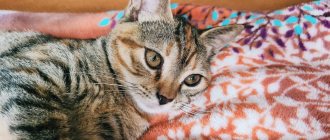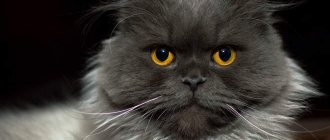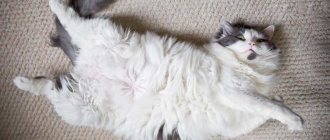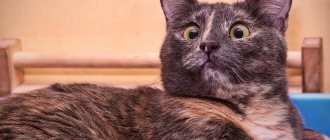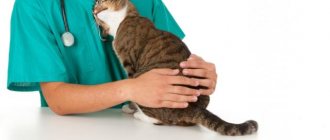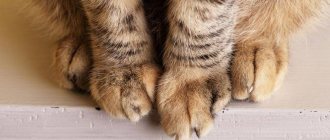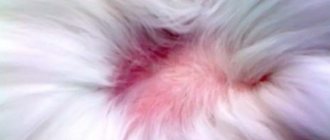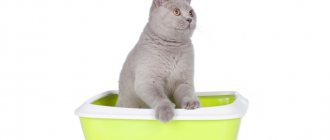Heart disease in cats, which can be congenital or acquired, is one of the most common causes of death of our smaller brothers. Recently, in veterinary medicine, heart diseases are quite often diagnosed in domestic animals of various age groups and breeds.
Unfortunately, cat breeders turn to the clinic when the disease reaches a chronic, extreme stage, and this in turn implies long-term and possibly lifelong therapy. In some cases, cardiac pathology can only be overcome by surgical treatment. Therefore, owners of furry pets should not only know the causes of development and main symptoms and manifestations of heart disease, but also take all possible measures to avoid life-threatening pathologies for their animals.
Causes of heart disease in cats
The heart of animals is practically no different from the human heart and performs the same functions in the body, taking part in blood circulation processes. The only difference is the ratio of the organ relative to body weight and heart rate. The heart distills oxygen and useful substances, saturating organs, tissues, and cellular structures with it.
Important! A cat's heart beats between 100 and 140 beats per minute. In kittens this figure is slightly higher. After activity, stress, or overheating, the heart rate increases.
Failures in the functioning of the cardiovascular system, cardiac pathologies of various etiopathogenesis worsen the quality, reduce the life expectancy of animals, lead to disruption of gas exchange, the functioning of internal organs and body systems.
Causes of heart disease in cats:
- hypo-, avitaminosis;
- viral-bacterial, parasitic infections (heartworms);
- frequent stress, nervous exhaustion;
- deterioration of vascular condition;
- shunts between heart chambers;
- excessive physical activity;
- poisoning with chemicals, potent chemicals;
- genetic, hereditary predisposition;
- metabolic disorders;
- intoxication;
- chronic inflammatory processes;
- sternum injuries;
- autoimmune diseases;
- unbalanced feeding, disruption of the nutritional system, diet poor in nutrients;
- chronic respiratory diseases, endocrine pathologies;
- age-related changes in the body.
Often, pathologies, heart disease in cats, and disturbances in the functioning of the cardiovascular system in animals occur against the background of diseases and infections of various etiologies and natures. For example, one of the causes of cardiopathy can be called disturbances in the functioning of the thyroid gland. Due to the increased production of thyroid-stimulating hormone, the walls of the ventricles of the heart thicken, the volume of ejected blood decreases, which leads to the fact that the heart literally works for wear and tear.
Often, heart disease develops against the background of diabetes, obesity, and parasitic infections. Long-term use of certain medications can also lead to disruption of the heart of animals.
Regarding breed predisposition, according to statistics, Bengals, Persian, Siamese, Thai, Abyssinian, Burmese cats and their mixed breeds suffer from heart ailments of various types.
In these breeds, kittens are often born with congenital heart defects. In this case, pathologies can develop at an older age.
In some cases, the causes of heart disease are unknown, and in order to determine what caused the malfunction of the cardiovascular system, a number of diagnostic studies and measures are required.
What is the cause of cardiomyopathy?
In most cases, veterinarians recognize the innate genetic and breed affiliation of cats with HCM. Possible provoking factors include:
- hyperthyroidism, acromegaly;
- hypertension;
- taurine deficiency, unhealthy diet;
- infiltration processes in the heart muscle;
- lymphoma;
- toxins, drugs.
Among cats predisposed to HCM are Maine Coons, Siamese, Britons, Sphynxes and others; they are carriers of the gene that is responsible for the development of cardiomyopathy. The higher the purity of the blood of elite cats, the more likely it is that they will have a lot of diseases of internal organs during examination.
Main symptoms
Symptoms, signs, and clinical manifestations of cardiac pathologies are ambiguous. The general picture, the intensity of symptoms depends on age, conditions of detention, the presence of secondary, concomitant systemic diseases, general physiological condition, individual characteristics, form, and the root cause of the disease.
Often, owners detect symptoms of heart disease when they enter the chronic stage, which can end tragically for their pet. Therefore, always carefully monitor the behavior and condition of your furry pet, and if there are any signs of discomfort or worsening of the condition, contact a veterinarian.
Important! Pathologies and diseases of the cardiovascular system can manifest themselves in cats of different age groups. Heart diseases are not always detected in elderly, old animals.
Signs of heart disease and pathologies in cats:
- weakness, decreased activity, lethargy, drowsiness;
- weak reaction to external stimuli;
- refusal to eat;
- heart rhythm disturbances (arrhythmia, tachycardia);
- fainting, signs of suffocation;
- breathing problems (shortness of breath, rapid breathing, cough);
- wheezing in the sternum, wheezing;
- pallor, cyanosis of mucous membranes;
- swelling on the body, ascites;
- dry nose;
- heart murmurs on auscultation;
- weight loss;
- fainting, convulsions, muscle spasms;
- temperature drop;
- violation of movement coordination.
Cats suffering from heart pathologies get tired quickly after active games or short activity. Animals may take unnatural positions and refuse food or treats offered.
Touching the sternum causes pain. Breathing is rapid (more than 35-40 breaths per minute at rest), shallow. Respiratory rate is measured by chest movement.
Important! The respiratory rate of cats is affected by weight, age, ambient temperature, and the condition of the animal. Thus, in pregnant and lactating cats, and in pets after physical activity, the respiratory rate is increased.
Due to oxygen starvation, animals stretch their necks forward and breathe with an open mouth. Cats often have swelling in their limbs and muzzle. Body temperature is unstable and in most cases low.
Heart pathologies in cats often cause convulsions, which are in many ways similar to epileptic seizures. Animals with heart failure try to move as little as possible and avoid physical activity. Possible loss of coordination of movements, frequent sudden fainting caused by dizziness, paralysis of the hind legs.
Given the non-specificity of symptoms, it is very important to carry out comprehensive diagnostic measures in the clinic as quickly as possible. Diagnosis of heart pathologies in animals is quite complex, is carried out using special equipment and requires highly qualified veterinarians.
Diagnosis
Radiography
Radiographic features of HCM include enlargement of the left atrium and varying degrees of enlargement of the left ventricle. The classic valentine-shaped heart appearance in dorsoventral and ventrodorsal views is not always present, although the position of the left ventricular apex is usually preserved. The cardiac silhouette appears normal in most cats with mild HCM. Dilated and tortuous pulmonary veins may be seen in cats with chronic increases in pulmonary vein and left atrium pressure. Left-sided congestive heart failure causes patchy infiltrates expressed to varying degrees with interstitial or alveolar pulmonary edema. Radiologically, the distribution of pulmonary edema is variable; A diffuse or localized distribution within lung fields is usually found, as opposed to the characteristic hilar distribution of cardiogenic pulmonary edema in dogs. Pleural effusion is common in cats with advanced or biventricular congestive heart failure.
Electrocardiography
The majority of cats with HCM (up to 70%) have electrocardiographic abnormalities. These include abnormalities characterized by left atrial and left ventricular enlargement, ventricular and/or (less commonly) supraventricular tachyarrhythmias, and signs of left bundle branch block. Atrioventricular conduction delay, complete atrioventricular block, or sinus bradycardia sometimes occur.
Echocardiography
Echocardiography is the best method for diagnosing and differentiating HCM from other diseases. The extent of hypertrophy and its distribution within the free wall of the left ventricle, interventricular septum and papillary muscles is revealed in M-mode and B-mode echo studies. Doppler ultrasound may demonstrate left ventricular systolic and diastolic abnormalities.
Widespread myocardial thickening is common, and hypertrophy is often asymmetrically detected in the left ventricular free wall, interventricular septum, and papillary muscles. Focal zones of hypertrophy also occur. Using B-mode helps ensure that the scanning direction is correct. Standard M-Mode measurements should be taken, but areas of thickening outside these standard positions should also be measured. Diagnosis at an early stage of the disease may be presumptive in cats with mild or only focal thickening. False-positive thickening (pseudohypertrophy) can occur with dehydration and sometimes with tachycardia. False diastole thickness measurements also occur when the ultrasound beam does not cross the wall/septum perpendicularly and when measurements are not taken at the end of diastole, which can occur without a simultaneous ECG, or when the use of B-mode is insufficient for a good measurement. A thickness of the free wall of the left ventricle or interventricular septum (correctly measured) of more than 5.5 mm is considered pathological. Cats with advanced HCM have a diastolic left ventricular septal or left ventricular free wall thickness of 8 mm or more, although the degree of hypertrophy does not necessarily correlate with the severity of clinical signs. Doppler assessments of diastolic function, such as isovolumic relaxation time, mitral inflow, and pulmonary venous velocity, as well as Doppler tissue imaging techniques, are increasingly being used to characterize disease.
Hypertrophy of the papillary muscles may be severe and obliteration of the left ventricle during systole has been observed in some cats. Increased echogenicity (brightness) of the papillary muscles and subendocardial areas is usually a marker of chronic myocardial ischemia with resultant fibrosis. Left ventricular shortening fraction is usually normal or increased. However, some cats have mild to moderate left ventricular dilatation and reduced contractility (contraction fraction 23-29%; normal contractility fraction 35-65%). Sometimes there is enlargement of the right ventricle and pleural or pericardial effusion.
Cats with dynamic left ventricular outflow tract obstruction also often have mitral valve SAM or early closure of the aortic valve leaflets on M-mode imaging. Doppler ultrasonography can demonstrate mitral regurgitation and turbulence in the left ventricular outflow tract, although positioning the ultrasound beam along the blood stream with maximum ventricular ejection velocity is often difficult and it is easy to underestimate the systolic gradient.
Enlargement of the left atrium can range from mild to severe. Spontaneous enhancement (rotation, smoke echo) is seen within the enlarged left atrium in some cats. It is assumed that this is the result of blood stasis with cell aggregation and is a precursor to thromboembolism. Thrombosis is sometimes visualized within the left atrium, usually in its appendage.
Other causes of myocardial hypertrophy must be excluded before a diagnosis of idiopathic HCM is made. Myocardial thickening may also occur due to infiltrative disease. Variations in myocardial echogenicity or wall irregularity may be detected in such cases.
Excess connective tissue appears as bright, linear echoes within the left ventricular cavity.
Clinicopathological features
Cats with moderate to severe HCM have high circulating concentrations of natriuretic peptides and cardiac troponins. In cats with congestive heart failure, plasma concentrations of tumor necrosis factor (TNF) have been found to be increased to varying degrees.
Figure 1 Radiographic findings in feline HCM. Lateral (A) and dorsoventral (B) views demonstrating left atrial enlargement and mild ventricular enlargement in a male domestic shorthair cat. Lateral © view in a cat with HCM and severe pulmonary edema
Figure 2 Electrocardiogram in a cat with HCM showing infrequent ventricular premature beats and left axis deviation. Leads 1,2,3, speed 2.5 mm/sec. 1cm=1 mV
Figure 3 Echocardiographic findings in feline HCM. M-mode image (A) at the level of the left ventricle in a 7-year-old male domestic shorthair cat. The thickness of the free wall of the left ventricle and the interventricular septum in diastole is approximately 8 mm. B-mode image (B) in the right parasternal short-axis view of the left ventricle during diastole (B) and systole© in a male Maine Coon with hypertrophic obstructive cardiopathy. In (B), note the hypertrophied and brightly colored papillary muscles. In ©, note the almost complete obliteration of the left ventricular chamber during systole. IVS, interventricular septum; LV, left ventricle; LVW, left ventricular free wall; RV, right ventricle
Figure 4 A, Mid-systole M-mode echo image in the cat from Figure 3 (B and C). An echo from the anterior mitral valve leaflet is visible in the left ventricular outflow tract (arrow) due to abnormal systolic movement of the anterior mitral valve leaflet toward the interventricular septum (SAM). B, M-mode echocardiogram at the level of the mitral valve, also demonstrating SAM (arrows).
Ao, aorta; LA, left atrium; LV, left ventricle.
Figure 5 Color Doppler image during systole in a male domestic longhaired cat with hypertrophic obstructive cardiopathy. Note the turbulent flow above the protrusion of the thickened interventricular septum into the lumen of the left ventricular outflow tract and the mild mitral regurgitation of the mitral valve that often accompanies SAM. Right parasternal position along the long axis of the left ventricle. Ao, aorta; LA, left atrium; LV, left ventricle.
Figure 6 Echocardiogram obtained from a right parasternal short-axis view of the left ventricle at the level of the aorta and left atrium in an older male domestic shorthair cat with restrictive cardiomyopathy. Note marked enlargement of the left atrium and thrombus (arrows) within the atrial appendage. A, aorta; LA, left atrium; RVOT, right ventricular outflow tract
Diagnosis of cardiac pathologies
It is impossible to independently determine cardiac pathology in a pet without experience and special equipment. Heart disease, even in its early stages, may not manifest itself for several years. This is why it is very important to take your pet at least once a year for a checkup.
The diagnosis is made taking into account the combination of a number of studies, which include:
- ECHO (echocardiography).
- ECG (electrocardiography). The electrical activity of the heart is measured.
- MRI, CT.
- Tonometry.
- Physical research.
- X-ray. This technique allows you to determine the size and shape of the heart.
- Laboratory tests (serological studies).
In addition to the basic techniques, the doctor collects medical history data and takes into account the specifics of clinical manifestations.
Heartworm (dirofilariasis)
Heartworm or dirofilariasis is a fairly common parasitic disease today. Previously, it was believed that this disease was a disease of more southern regions, but statistics have changed greatly in recent years, and dirofilariasis began to be recorded in Moscow and the region, and even St. Petersburg.
Symptoms can be hidden or obvious. With obvious symptoms, the pet owner will observe a picture of heart failure:
- fast fatiguability;
- dyspnea;
- pallor of the mucous membranes.
Dirofilariasis is transmitted from mosquitoes to animals and people. Dirofilariae live, multiply and circulate constantly in the bloodstream, heart, subcutaneous tissue and muscles. These are viviparous organisms; their larvae, stage 1 microfilariae, can circulate in the blood of an infected dog for up to 2.5 years without causing any symptoms. If such a dog is bitten by a mosquito, the larva in it goes through the following stages of development in 2-3 weeks and becomes invasive, that is, capable of infecting the next organism. When bitten by an infected mosquito, the infective larvae enter the dog's subcutaneous tissue, where they mature further. The larvae of the 5th stage penetrate the blood vessels, are carried by the blood flow into the heart and large vessels, and after 6 months they become adult, sexually mature helminths and can reach 35 cm in length, causing harm to organs and tissues. The danger of this disease lies in thromboembolism by adult helminths in the heart and instant death of the animal.
Treatment and prevention
Self-medication if a cat has a heart disease, regardless of the degree of complexity, can lead to serious consequences. Therapy should be prescribed by the attending veterinarian, having the diagnostic results in hand. The choice of methods depends on the form, stage, complexity of cardiovascular pathology, as well as on the age, physiological state of the animals, and the root cause.
Important! If the pathology is detected at the initial stage of development, the animal is registered with the veterinary clinic. In the future, the veterinarian-cardiologist monitors the treatment and condition of the sick patient.
Treatment of most heart diseases in the early stages of development involves drug therapy. Cardiac glycosides, anticoagulants, drugs that normalize heartbeat, blood pressure, diuretics, restoratives, and symptomatic drugs in injections or tablets are used. Animals are prescribed a special diet, medicinal feed, enzyme agents, vitamins, mineral supplements, and immunomodulators.
The main goal of cardiac therapy is to normalize the functioning of the heart, stop destructive processes in the organ, improve the condition of blood vessels, prevent the formation of blood clots, and correct blood pressure. For each individual pathology, appropriate treatment and certain medications are prescribed.
Sick pets require optimal living conditions and a complete fortified diet. Food should contain proteins, taurine, vitamin A, B3, B6, B12, calcium, phosphorus, magnesium, iron, essential amino acids. It is very important to protect cats from stress, which not only disrupts the functioning of the heart, but also weakens the body.
In severe cases, to eliminate anatomical defects, if drug treatment does not produce results, surgical treatment is used, after which maintenance therapy is prescribed. If it is not possible to completely restore organ function, cats are prescribed lifelong treatment.
General information about the heart as an organ and the mechanism of its work
Like most mammals, the cat's heart is the main link in the general blood flow system. This muscle, which has a cavity inside, is located in the chest area. The myocardium is a kind of pump for pumping blood throughout the body and saturating each cell with all the useful elements.
At the initial stages, blood penetrates into the right half of the myocardium, and then through the pulmonary artery it is pumped to the pulmonary structures and saturates the cells with oxygen. Next, oxygenated blood enters the left half, which pumps blood into the aorta and spreads throughout the body. The right and left sides of the myocardium have upper chambers called atria and lower chambers called ventricles.
The structural element of the myocardium is two main valves - tricuspid and mitral. They are necessary to prevent the return of blood to the atrium from the ventricles during contraction. The muscle fibers of the ventricles are connected to the valves using specific tendons that prevent them from being pushed towards the atria.
The heart muscle is an important component of the animal’s body. The function of the heart is to pump blood, rich in essential oxygen and other nutrients, through large and small vessels to all cells of the body. Pathologies in the myocardium are based on a decrease in the efficiency of the blood pumping process. As a result, this leads to a large accumulation of fluid in the sternum and abdominal area.
In veterinary medicine, there are two types of heart diseases - one type involves damage to the heart valve itself, and the second affects the myocardium itself. In both the first and second cases, pathologies can be dealt with by establishing proper nutrition and dosed exercise.
In the case of severe cardiac pathologies, it is necessary to regularly check with veterinary specialists and, if necessary, give the animal medications prescribed by a doctor. Regular consultations at a veterinary clinic and a properly selected diet can normalize the cat’s condition and allow the animal to live a normal life.
Types of Heart Diseases
Heart disease can be congenital or acquired. At the same time, they are all united by gradual progression. Heart diseases can be acute, subacute, or chronic.
Birth defects
Some heart diseases and pathologies in cats are congenital and hereditary. However, they are not common, only in 2.5-4% of kittens. The most commonly diagnosed malformations of the heart valve are septal openings.
These pathologies include:
- stenosis (narrowing) of the aorta;
- stenosis of the ventricular efferent valve;
- defects of the interventricular and intervalvular septa;
- pulmonary stenosis;
- triatrial heart;
- endocardial fibroelastosis.
Important! Congenital heart pathologies manifest themselves at young and older ages. It all depends on the care, conditions of detention, individual, physiological parameters
Defects in the development of the valve apparatus are detected at the mitral valve, which is located between the left ventricle and the left atrium. If the valve does not close properly, its functioning is impaired, blood does not flow into the atrium, which will lead to malfunction of the heart and accumulation of blood between the chambers of the organ.
Symptoms of congenital heart pathologies vary depending on the specific disease. Anemia of the mucous membranes and skin, excessive thirst, irregular heart rhythm, respiratory failure, weakness, drowsiness, increased thirst, decreased activity - these are the main manifestations of congenital heart pathologies in cats.
The prognosis for congenital heart pathologies is in most cases unfavorable. Drug treatment provides improvement, but animals, if there are no contraindications, are prescribed surgery.
Heart pathologies
It is simply impossible to consider heart pathologies that are diagnosed in cats in one article. Each disease requires special attention and review. Therefore, let’s imagine diseases that are diagnosed in veterinary medicine.
Cats are diagnosed
- pericarditis (inflammation of the pericardium);
- myocarditis;
- myocardosis (dystrophy of the heart muscle);
- cardiac arrhythmias, which, although not the main disease, indicate malfunctions of the cardiovascular system.
One of the common pathologies is endocarditis . Manifested by inflammation of the inner lining of the muscle. It occurs acutely and chronically. Depending on the localization of the process, it can be parietal (verrucous), valve (ulcerous). The nature of the changes is warty, ulcerative.
Pericarditis in cats is often idiopathic. The pathology is accompanied by impaired blood flow, destructive, dystrophic, necrotic processes in the tissues of the organ.
Causes of pericarditis: hypothermia, weakened resistance, overwork, frequent stress. The initial stage is characterized by fibrin deposition, the formation of adhesions, and cardiac murmurs. Dry pericarditis in cats often turns into an exudative form. Parenchymal edema of organs and intoxication due to exposure to toxic products gradually develop.
Symptoms depend on the stage of development:
- tachycardia is noted;
- tachysystole;
- fever;
- pain in the heart area;
- symptoms of dehydration.
Arrhythmia, tachycardia, and other heart rhythm disturbances are not a separate pathology, but a symptom, a manifestation of some pathology or a consequence of inflammatory processes.
Treatment for any pathology is aimed at normalizing heart function, adjusting blood pressure, and eliminating the root cause.
Mechanism of disease development
There are several types of pathologies in the heart area. The first type is valve disease, characterized by a decrease in the amount of blood entering the body due to blood leaking through the valve itself. The second type of pathology is myocardial diseases, characterized by a general weakening or thickening of the heart muscle, which results in a decrease in the efficiency of blood pumping.
There is no single common cause for the development of heart pathologies. But problems with diet are more likely to lead to cardiovascular disease. In addition, the mechanism for the development of heart disease is based on the general physical condition of the animal. Thus, cats that are overweight are more often susceptible to pathological conditions of the myocardium.
The age of the pet plays an important role, because the older the pet, the higher the likelihood of developing cardiomyopathies. Some cat breeds, such as American Shorthairs, Maine Coons and Persians, have a genetic predisposition to developing heart disease.
Cardimopathy
Among all disorders of the heart, cardiomyopathy is most often diagnosed in cats of various age groups and breeds. Pathology caused by structural abnormalities in the muscular structures of a hollow organ inevitably leads to disruption and dysfunction of the pumping system. In severe cases, congestive heart failure develops, which will lead to anemia and oxygen starvation.
Due to the accumulation of fluid in the pulmonary circulation, respiratory distress syndrome develops. Leads to the formation of blood clots that clog blood vessels. In cats, edema, paralysis, paresis of the hind limbs, acute anemia, and fainting are noted. If treatment is not started in time, the disease is fatal in 100% of cases.
Most cardiopathies in animals are of primary origin. The secondary form of the disease develops rarely and can be caused by surges in blood pressure, anemia, and hyperthyroidism.
In veterinary medicine, there are four types of primary cardiomyopathies in cats:
- Hypertrophic. Characterized by thickening of the myocardium, increased pressure in the cavities of the heart. Leads to the development of acute heart failure.
- Restrictive. With this pathology, there is a loss of elasticity of the myocardium, which leads to degeneration of organ tissue. The systolic and diastolic function of the heart muscle is impaired.
- Dilatational. Characterized by thinning and stretching of the heart walls. The heart enlarges and its contractile function is impaired.
- Arrhythmogenic. A rare genetically determined disease characterized by the replacement of normal tissues with fibrofatty tissue. The pathological process mainly involves the right ventricle.
Each disease has its own specific symptoms and manifestations. Some diseases have a genetic, hereditary origin. Thus, hypertrophic cardiomyopathy is most often noted in Sphynx cats, Norwegian Forest cats, British cats, Maine Coons, Siamese, Abyssinian cats, as well as Redgall and Scottish Fold breeds.
Symptoms
Behavior changes in cats with cardiomyopathy. The condition may be stable until the pathology reaches a critical stage. The disease is manifested by weakness, drowsiness, breathing problems, and unstable temperature. Pulse and blood pressure changes.
Sharp changes in emotional state are noted. Bouts of calm are replaced by increased excitability. Cats meow pitifully, demanding the attention of their owners, hiding in secluded places.
Treatment
Treatment of cardiomyopathies in cats depends on the form and severity of the disease and is most effective at an early stage of development. Therapy is selected individually, in each specific case.
Used in treatment:
- beta blockers;
- medications to prevent thromboembolism;
- blood thinners;
- diuretics;
- calcium channel blocking drugs;
- vitamins;
- homeopathy.
If cardiomyopathy of any form and etiology is detected, the animals, despite their breed qualities, are removed from breeding.
Which pets are more likely to have heart problems?
In most cases, myocardial problems appear with age. In dwarf and small dogs, the valves often become thickened and deformed. Yorkshire terriers, chihuahuas, dachshunds, toy terriers, and Pekingese are at risk.
Large and giant dog breeds, as well as cocker spaniels, are prone to dilated cardiomyopathy. The disease is characterized by expansion of all chambers of the heart, impaired ability to contract, rapid development of arrhythmia, and heart failure.
Dilated cardiomyopathy also occurs in cats, but more often – hypertrophic cardiomyopathy (65% of cases). With this pathology, the walls of the myocardium thicken completely or partially, and the ventricular cavity decreases. The problem often occurs in Maine Coons, Ragdolls, Sphinxes, British Shorthairs, and Scottish Folds.

